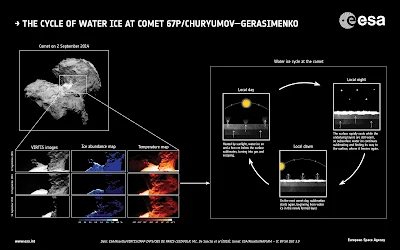Εντοπίστηκε
διαδικασία «κύκλου νερού» στην επιφάνεια. Measurements made
by the European Space Agency's Rosetta spacecraft have found the comet
67P/Churyumov–Gerasimenko has its own water cycle as it gently spins
(illustrated). During the day water vapour travels from deep in the comet and
freezes on the surface at night, only to be vapourised at dawn. Copyright Data:
ESA/Rosetta/VIRTIS/INAF-IAPS/OBS DE PARIS-LESIA/DLR; M.C. De Sanctis et al
(2015); Comet: ESA/Rosetta/NavCam – CC BY-SA IGO 3.0
Τελικά
ακόμη και οι κομήτες αποδεικνύεται ότι διαθέτουν κάποια περιορισμένης μορφής
καιρικά φαινόμενα. Το σκάφος Rosseta που ακολουθεί κατά πόδας τον κομήτη 67/P
έκανε μια ακόμη εντυπωσιακή ανακάλυψη.
Την
νύχτα δημιουργείται πάγος στην επιφάνεια του κομήτη 67/P ο οποίος όταν πέσει πάνω του ο ήλιος
εξαχνώνεται και σχηματίζεται εκ νέου όταν πέσει το σκοτάδι. This
single frame Rosetta navigation camera image was acquired at 01:04 GMT on 13
August 2015, just one hour before Comet 67P/Churyumov–Gerasimenko reached
perihelion – the closest point to the Sun along its 6.5-year orbit. The image
was taken around 327 km from the comet. It has a resolution of 28 m/pixel,
measures 28.6 km across and was processed to bring out the details of the comet's
activity. Copyright: ESA/Rosetta/NAVCAM – CC BY-SA IGO 3.0
Διαπίστωσε
ότι ο κομήτης διαθέτει ένας μικρής κλίμακας καιρικό σύστημα. Το σκάφος εντόπισε
κάποια στιγμή την ύπαρξη στερεού πάγου έκτασης ενός τετραγωνικού χλμ πάνω στον
κομήτη και όπως διαπιστώθηκε ο πάγος αυτός ήταν προϊόν της εναλλαγής
μέρας-νύχτας στον κομήτη.
As a comet's orbit
takes it nearer to the sun its activity increases, causing ices to vaporise and
gas jets to burst out from its interior. One recent outburst (pictured) was so
powerful it even pushed away the solar wind.
Όπως
διαπίστωσαν τα μέλη της αποστολής κατά τη διάρκεια της νύχτας στην επιφάνεια
του κομήτη σχηματίζεται ο στερεός πάγος ο οποίος όταν αργότερα πέσουν πάνω του
ακτίνες του ήλιου εξαχνώνεται (γίνεται αέριο) και εγκαταλείπει τον κομήτη
ταξιδεύοντας στο διαστημικό κενό.
The researchers
examined a section of the 'neck' of the comet which has been found to be
particularly active for water ice outbursts. They found ice abundance changed
with the temperature of the surface (pictured).
Όταν
ο ήλιος φύγει στην επιφάνεια επιστρέφει ο πάγος που προέρχεται από το εσωτερικό
του κομήτη. Η ανακάλυψη δημοσιεύεται στην επιθεώρηση «Nature».





Δεν υπάρχουν σχόλια:
Δημοσίευση σχολίου